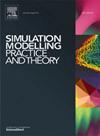Robust optimization method for co-simulation of equipment based on EDEM-ADAMS
IF 3.5
2区 计算机科学
Q2 COMPUTER SCIENCE, INTERDISCIPLINARY APPLICATIONS
引用次数: 0
Abstract
Tunneling machines, pivotal in rock tunnel excavation, utilize cutting mechanisms for rock fragmentation. As the core component of the cutting mechanism, the cutting head experiences severe vibrations during the rock breaking process when subjected to large loads, which adversely affects the working performance of the tunneling machines. The precision and efficiency of cutting force simulation for the cutting head are crucial for equipment design optimization and performance assessment. Therefore, exploring robust simulation time steps is particularly significant. This paper leverages state-of-the-art simulation techniques to boost the accuracy and computational performance of cutting head simulation. Firstly, by setting 44 different combinations of EDEM-ADAMS time steps, simulations are conducted in four different environments to collect cutting forces and simulation time data. Then, in view of this dataset, the radial basis function (RBF) approximation model is developed to simultaneously predict cutting forces and simulation time under four environments, which enhances the accuracy and applicability of the predictions. Finally, targeting the minimization of relative error, fluctuation magnitude, and simulation time, the NSGA-II algorithm is further utilized for multi-objective iterative optimization to obtain the time step combination with excellent performance. The results demonstrate that the optimized method reduces the relative error by 67.8 %, the fluctuation magnitude by 43.6 %, and the simulation time by 31.8 %. These improvements highlight the effectiveness of the optimization approach in enhancing both the precision of cutting force prediction and the stability of the simulation process, while maintaining computational efficiency.
基于 EDEM-ADAMS 的设备协同仿真稳健优化方法
隧道掘进机是岩石隧道开挖的关键,它利用切割机制来破碎岩石。切割头作为切割机构的核心部件,在大载荷作用下,在破岩过程中会产生剧烈的振动,对掘进机的工作性能产生不利影响。切削头切削力仿真的精度和效率对于设备设计优化和性能评估至关重要。因此,探索鲁棒仿真时间步长尤为重要。本文利用最先进的仿真技术来提高切割头仿真的精度和计算性能。首先,通过设置44种不同的EDEM-ADAMS时间步长组合,在4种不同的环境下进行仿真,采集切削力和仿真时间数据。然后,针对该数据集,建立径向基函数(RBF)近似模型,同时预测四种环境下的切削力和仿真时间,提高了预测的准确性和适用性。最后,以相对误差最小、波动幅度最小、仿真时间最小为目标,进一步利用NSGA-II算法进行多目标迭代优化,得到性能优异的时间步长组合。结果表明,优化后的方法使相对误差减小了67.8%,波动幅度减小了43.6%,仿真时间缩短了31.8%。这些改进突出了优化方法在保持计算效率的同时,在提高切削力预测精度和仿真过程稳定性方面的有效性。
本文章由计算机程序翻译,如有差异,请以英文原文为准。
求助全文
约1分钟内获得全文
求助全文
来源期刊

Simulation Modelling Practice and Theory
工程技术-计算机:跨学科应用
CiteScore
9.80
自引率
4.80%
发文量
142
审稿时长
21 days
期刊介绍:
The journal Simulation Modelling Practice and Theory provides a forum for original, high-quality papers dealing with any aspect of systems simulation and modelling.
The journal aims at being a reference and a powerful tool to all those professionally active and/or interested in the methods and applications of simulation. Submitted papers will be peer reviewed and must significantly contribute to modelling and simulation in general or use modelling and simulation in application areas.
Paper submission is solicited on:
• theoretical aspects of modelling and simulation including formal modelling, model-checking, random number generators, sensitivity analysis, variance reduction techniques, experimental design, meta-modelling, methods and algorithms for validation and verification, selection and comparison procedures etc.;
• methodology and application of modelling and simulation in any area, including computer systems, networks, real-time and embedded systems, mobile and intelligent agents, manufacturing and transportation systems, management, engineering, biomedical engineering, economics, ecology and environment, education, transaction handling, etc.;
• simulation languages and environments including those, specific to distributed computing, grid computing, high performance computers or computer networks, etc.;
• distributed and real-time simulation, simulation interoperability;
• tools for high performance computing simulation, including dedicated architectures and parallel computing.
 求助内容:
求助内容: 应助结果提醒方式:
应助结果提醒方式:


